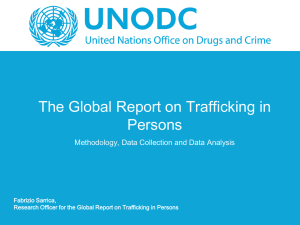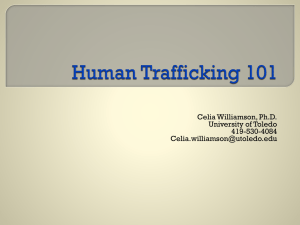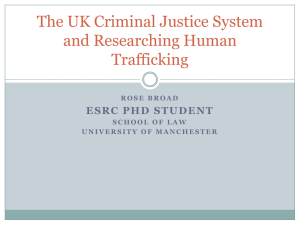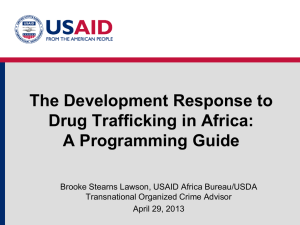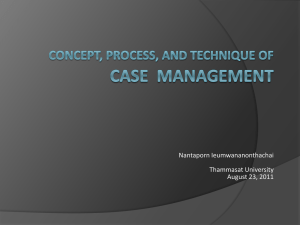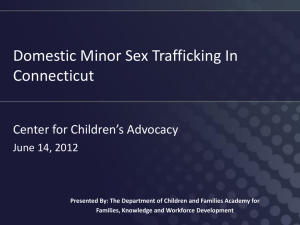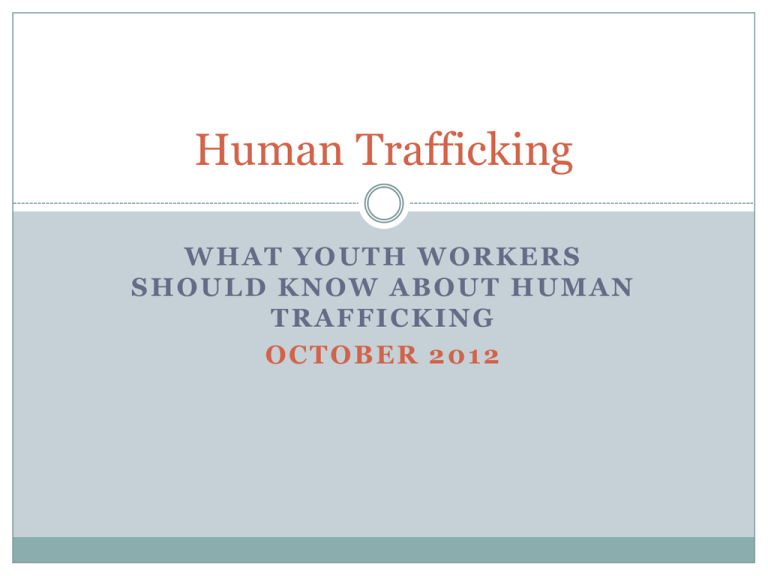
Human Trafficking
WHAT YOUTH WORKERS
SHOULD KNOW ABOUT HUMAN
TRAFFICKING
OCTOBER 2012
Basics of Trafficking
WHAT IS HUMAN
TRAFFICKING?
Response to Human Trafficking
International
UN Convention against Transnational Organized Crime
(Protocol on Human Trafficking)
National
Trafficking Victims Protection Act (TVPA)
New York State
NYS Human Trafficking Law
Elements of Human Trafficking
1
PROCESS
Recruiting
OR
Harboring
OR
Moving
OR
Obtaining
2
MEANS
by
Force
OR
Fraud
OR
Coercion
(specific acts in NYS PL)
Source: Freedom Network Training Institute
3
END
For the purposes of
Involuntary Servitude
OR
Debt Bondage
OR
Slavery
OR
Commercial Sex Acts
TVPA & Subsequent Reauthorizations
Federal law passed in 2000
Focus on prevention, protection, and prosecution
A person who is trafficked is considered a victim of a
serious crime under US law and has the right to
protection and assistance.
The TVPRA builds upon these efforts and attempts
to remove “unintended obstacles.”
NYS Human Trafficking Law
Crimes
Class B felony for sex trafficking
Class D felony for labor trafficking
Felony for charges for “Prostitution Tourism”
Services
Provides victims with basic services
Inter Agency Coordination
Interagency Task Force on Human Trafficking
Sex Trafficking- NYS Definition
Profiting from prostitution by:
providing drugs;
using false or misleading statements;
withholding or destroying government documents;
debt servicing;
force;
a plan or pattern of coercive conduct; OR
other acts.
Labor Trafficking- NYS Definition
Compelling or inducing another to engage in labor,
or recruiting, enticing, harboring or transporting
another by:
providing drugs;
withholding or destroying government
documents;
debt servicing;
force; OR
a plan or pattern of coercive conduct.
Trafficking Power & Control Wheel
NYS Anti-trafficking Law Implementation
In January 2009, NYS OCFS and OTDA jointly
issued OTDA 09-ADM-01/09-OCFS-ADM-01 New
York State Anti-Trafficking Statute, which gives
policy and procedural guidelines to LDSSs
regarding Human Trafficking.
Human Trafficking Liaisons
Providing assistance to minor victims
Determining eligibility for assistance for state-confirmed
victims
Facilitating services through RHTPs for foreign victims
Reporting to the NYS Anti-Trafficking Program Coordinator
Safe Harbour for Exploited Youth Act
Effective April 1, 2010.
Creates a presumption that a person under 16 who is
charged as a JD for a prostitution offence is a severely
trafficked person.
Requires the court to proceed with a PINS petition,
rather than JD petition.
In certain circumstances the court has discretion to
continue with the JD petition.
Court can convert a PINS to a JD petition if youth is
out of compliance with court orders.
If funded, short-term services provided by LDSSs
(more on this later)
Myths
Myths & Misconceptions
Trafficking victims have to be foreign nationals.
Trafficking requires an international or state border
crossing.
Trafficking victims must be kidnapped and/or
restrained physically.
If a victim consented prior to abuse or was paid, then
it is not trafficking.
Smuggling vs. Trafficking
Smuggling entails:
A facilitated entry
Element of consent
Violation of immigration law but not necessarily a human
rights violation
Intersection of Human
Trafficking & Child Welfare
EVERY TWO MINUTES A CHILD IS
TRAFFICKED FOR THE PURPOSE OF
SEXUAL EXPLOITATION IN THE
UNITED STATES.
—U.S. DEPARTMENT OF JUSTICE
Do you know Lacy?
Human Trafficking of Children/Youth
Minor Victim Human Trafficking
When the human trafficking victim is under 18 years old.
Sex Trafficking, Labor Trafficking or Domestic Servitude
U.S. Citizens, legal permanent residents, or undocumented
Domestic Minor Sex Trafficking
When a U.S. citizen or legal permanent resident victim under
18 years old is engaged in a commercial sex act.
Commercial sex act is any sex act on account of which anything of
value is given to or received by a person. This includes:
Prostitution,
Exotic dancing/stripping, or
Pornography.
Quick Facts on Trafficking
More than 80% of trafficking victims are female
and over 50% are children.
The average entry age for prostitution in the U.S. is
now 13.
Estimates of domestic minors involved in sex
trafficking range from 100,000 to 300,000.
Domestic Minor Trafficking
• Who are the victims of domestic
minor trafficking?
Youth of any ethnicity, race, or religion.
Youth of any socio-economic class.
Female, male, and transgender youth.
Youth of all ages.
Vulnerable youth.
Domestic Minor Sex Trafficking
• Who are especially vulnerable to
domestic minor sex trafficking?
Youth
with histories of abuse.
Homeless, or runaway youth.
Youth within the foster care system, esp. congregate
care.
LGBTQ youth.
Intersection with Runaway &
Homeless Youth
Runaway & Homeless Youth
Runaway/ Homeless Youth
According to the U.S. Office of Juvenile Justice and Delinquency
Prevention, 85% of exploited children are missing when exploitation
occurs.
Pimps and exploiters target youth shelters, group homes, and other
services for homeless youth.
Exploiters offer a place to stay, food, a new pair of jeans, at the least
some attention. Children with no system of support are at high risk
for these methods of seduction, coercion, and recruitment.
NISMART (National Institute for Missing, Abducted,
Runaway and Throwaway Children) estimates that
nationally
1.6 million children run away from home each year and that one out
of every three teens on the street will be lured toward the sex
industry within 48 hours of leaving home.
High Risk Victims
•
High Risk Victims:
Multiple runaway incidents
o
4 or more times in 12 month period
Sexually exploited
Age (12 and under)
Time missing (over 1 month)
Repeat victims
Victims of prostitution/trafficking
Defined by the High-Risk Victims & Trafficking Team of the Dallas Police Department, 2006
The Role of Runaway and Homeless Youth Shelters
•
•
•
•
24/7 Access to safe, comfortable, non-system
location staffed with professional child care
workers.
Home like environment, which is crisis free,
positive, stable and typically an anonymous
location.
Immediate access to food, clothing, medical care
and other basic needs.
Ability to establish rapport with caring adults and
aid in coordination of service delivery.
The Role of Runaway and Homeless Youth Shelters
Therapeutic model of care which promotes:
Inclusion
Trauma Informed Approach
Harm Reduction Strategies
Positive Youth Development
Full time Case Managers
All youth receive a Individual Service Plan
Meet with Case Manager to develop rapport
Begin the process of Family Reunification where appropriate
Access to school
The Role of Runaway and Homeless Youth Shelters
RHY Shelters can help minor victims by:
Providing a positive and stabilizing environment.
Aid in beginning immediate service provision.
Help with service coordination and after-care support services.
Build rapport with youth.
Help youth leave the streets, the lifestyle and see a way to a
brighter future.
Trafficking Recruitment
HOW DO TRAFFICKERS FIND AND KEEP
THEIR VICTIMS?
How do traffickers (pimps) find victims?
Recruitment
From the street
Schools
Shelters, foster homes, group homes, etc
Malls
Facebook
Abduction
Purchase or trade from another pimp
Recruitment
Pimps(traffickers) manipulate their victims with an
initial period of false love and feigned affection.
This period often includes:
Warmth, gifts, compliments, and sexual and physical intimacy
Elaborate promises of a better life, fast money, and future luxuries
Purposeful and pre-meditated targeting of vulnerability (e.g.
runaways, foster care youth)
Purposeful targeting of minors due to naiveté, virginity, and youthful
appearance.
This initial period is critical to attaining long-term mind
control over victims.
From Domestic Sex Trafficking: The Criminal Operations of the American Pimp, Polaris Project
Grooming
Grooming is a two-stage process prior to
“turning out” a girl.
First, the girl is made to feel attractive and wanted. The
pimp spends money on her and gives her special
treatment.
Sex between the pimp and the girl is always part of the
grooming process.
From Domestic Sex Trafficking: The Criminal Operations of the American Pimp, Polaris
Project
Grooming
Stage two, the pimp will attempt to break a girl’s will
through physical, sexual and verbal abuse to prepare
her for the “game”.
Often involves gang rape.
Pimp moves her around to break her from family/friend ties.
He was real sweet at first, then he began telling
me, “You can’t stay in this house for free.”
-Sharon, 17 year old
From Domestic Sex Trafficking: The Criminal Operations of the American Pimp, Polaris
Project
Why don’t victims seek help?
Use and/or threat of violence
Fear
Shame
Self-blame
Hopelessness
Dependency
Victims have become physically, financially, or emotionally
dependent on the trafficker.
They have bonded with the abuser through traumatic bonding
From “Understanding Victim’s Mindset”. Polaris Project 2006
Why don’t victims seek help?
Distrust of law enforcement
False promises
Victims are promised love, money, safety
Lack of knowledge of social systems
Victims don’t know how and where to seek help
Debt bondage
Victims are sometimes trapped in never ending cycles of
fabricated debt and are made to believe they cannot leave until
this debt is paid off.
From “Understanding Victim’s Mindset”. Polaris Project 2006
Identification of
Victims/Warning Signs
Identifying Child/Youth Victims
Child victims of trafficking will usually look like the
children you help every day.
Children will rarely disclose, or even realize, they are
trafficking victims.
Many view their trafficker as a boyfriend, and the
process of breaking that bond is time and resource
intensive.
Some children may still be under the control of the
pimp/trafficker, even after they are returned to
foster care, a family home or are rescued.
Identifying Child/Youth Victims
Trafficked children often suffer from depression,
hostility, stress, anxiety, post-traumatic stress
disorder, and fear of authority, as well as those who
victimize them.
Outward symptoms may present as difficult behavior
or resistance to assistance.
Other physical symptoms may be present, such as
pregnancy, sexually transmitted diseases, and drug
addiction, may mask the fact they have been
exploited.
Identifying Child/Youth Victims: What to Look For?
Unexplained absences from
school for a period of time
Chronic running away (from
home or foster care)
Frequent travel to other cities
Controlled/restricted
communication – not allowed
to speak to you alone
Expensive gifts
More than one cell phone
Living in a hotel (has key or
business card)
Suspicious jewelry or tattoo
(“branded”)
Signs of trauma, fatigue,
injuries, abuse or depression
Signs of hunger/
malnourishment
Inappropriately dressed
Fear/mistrust of law
enforcement/social
service/CPS workers
Engaged in sexual situations
beyond age-specific norms
Has a noticeably older
“boyfriend” (i.e., 10+ years)
Sources: DCJS (2008); IACP (2006); NHTRC (nd); OSDFS (nd); VIJ (2004)
Identification of Child/Youth Victims
Due to the covert nature of human trafficking,
victims can come to your attention indirectly
through other means or as a result of another issue,
such as:
Prostitution
Domestic Violence
Drug usage
Runaways and homeless youth
Juvenile Delinquents, Persons in Need of Supervision (PINS)
cases or Foster Care
Cases of sexual abuse or neglect
Child Trafficking Indicator Questions
Are you in school?
If you work, what kind of job do you have? How are you
paid?
Where do you live? Are you able to leave the
house/apartment whenever you want to?
What are the rules where you live or work?
Tell me about your typical day.
Are you (or were you) hurt?
Were you able to talk to your family and friends? If so,
were you alone?
If from another country, how did you get to the U.S.? Do
you have your documents or does someone else?
Excerpt from Building Child Welfare Response to Child Trafficking, Center for Human Rights for Children,
Loyola University Chicago and International Organization for Adolescents (IOFA)
Why do providers need to know this?
Service providers who work with children and
youth need to be aware of the signs of human
trafficking.
If it appears that a child may have been trafficked:
If unsure, you can contact the National Human Trafficking
Resource Center 1-888-373-7888.
If appropriate, a referral should be made to law
enforcement professionals to assess the situation.
Law
enforcement may refer the child to OTDA for the
confirmation or certification process.
If no “official” referral is made for confirmation or
certification, child may still need services.
Engaging Child/Youth Victims
Things to Consider Before an Interview
Trafficking victims rarely self-identify as trafficking victims;
usually present with another form of abuse, neglect, or
abandonment
Trafficking victims may be fearful of disclosing information
due to threats by trafficker of harm to him/her or his/her
family
It may take several interviews to establish trust and determine if
someone has been trafficked
If possible, do not take extensive notes during initial interview(s)
Child’s parent or caregiver may also be the trafficker
Trafficker may lie and say s/he is a child’s parent or
caregiver
Source: DCF (nd); UK Home Office (nd)
Tips for Conducting an Interview
Hold interviews in a private, secure location
Respect victim’s privacy & confidentiality
Do not discuss the case with anyone who doesn’t need to know
Do not expose victim to the media
Use interpreter(s) when necessary, but screen to ensure that they:
Understand dynamics of trafficking
Are not allied with the trafficker
Understand needs of child victims (if applicable)
Establish that you do not work for the government/police
Ensure victim’s cell phone is turned off during the interview (may be
used as a method of control by the trafficker)
Build rapport before asking about immigration status, sexual
abuse/experiences, or other potentially difficult subjects
If possible, find out if other victims are being held
Source: DCF (2009); UK Home Office (nd)
Tips For Initial Consultation(s)
Hold interviews in a private, secure location.
Establish separation between your shelter/program &
government/police.
Respect privacy & confidentiality.
Do not discuss the case with anyone who doesn’t need to
know
Do not take extensive notes during initial interview(s)
Do not expose victim to the media
Use interpreter(s) when necessary, but screen to ensure
that they:
Understand dynamics of trafficking & are not allied with the
trafficker
Build rapport before asking about immigration status,
sexual abuse/experiences, or other sensitive subjects.
Sources: DCF (nd); UK Home Office (nd)
Child Advocacy Centers
WHAT IS A CHILD ADVOCACY
CENTER?
HOW THEY MIGHT INTERSECT WITH
CHILD TRAFFICKING VICTIMS?
Children’s Advocacy Centers
New York State office of Children
and Family Services
OCFS STANDARDS
Child Focused Setting
Multidisciplinary Team
Organizational Capacity
Cultural Competency and Diversity
Forensic Interviews
Medical Evaluation
Mental Health
Victim Support and Advocacy
Case Review
Case Tracking
Child Advocacy Centers and
Multidisciplinary Teams
Mission is to promote and support
communities in providing a coordinated
investigation and comprehensive
response to child victims of abuse
PHILOSOPHY OF CAC MODEL
Primary focus is the child victim & family
Agencies working together in a coordinated community
response to child abuse
Physical plant to serve as a neutral facility
Warm, private, non-threatening environment
THE LAW
Executive Law §642-a provides that, whenever practicable and where one exists, an MDT and/or
a child advocacy center (CAC) shall be used for the investigation and prosecution of child abuse
cases, including sexual abuse, and child deaths. Section 423(6) of the SSL also has provisions
encouraging the use of an MDT for cases involving abuse and the death of a child. Therefore,
although a joint investigation is only required for reports alleging physical and sexual abuse and
reports involving the death of a child, as referenced in SSL § 424(5-a) and (5-b), the use of an
MDT or CAC should still be considered for other types of reports whenever possible.
Social Services Law section 423-a:
5. (a) The files, reports, records, communications, working papers or videotaped interviews used
or developed in providing services under this section are confidential. Provided, however, that
disclosure may be made to members of a multidisciplinary investigative team who are engaged
in the investigation of a particular case and who need access to the information in order to
perform their duties for purposes consistent with this section and to other employees of a child
advocacy center who are involved in tracking cases for the child advocacy center. Disclosure
shall also be made for the purpose of investigation, prosecution and/or adjudication in any
relevant court proceeding or, upon written release by any non-offending parent, for the purpose
of counseling for the child victim.
(b) Any public or private department, agency or organization may share with a child advocacy
center information that is made confidential by law when it is needed to provide or secure
services pursuant to this section. Confidential information shared with or provided to a center
remains the property of the providing organization.
1: Child Focused Setting
Standard: A Child
focused setting is
comfortable, private,
and both physically and
psychologically safe for
diverse populations of
children and their nonoffending family
2. Multidisciplinary Team
Standard: A multidisciplinary team for response to
child abuse allegations includes representation from
the following:
law enforcement
child protective services
prosecution
mental health
medical
victim advocacy
children’s advocacy center
3. Organizational Capacity
Standard: A designated legal entity responsible for
program and fiscal operations has been established
and implements basic sound administrative
practices.
4. Cultural Competency & Diversity
• Standard: Cultural competent services
are routinely made available to all CAC
clients and coordinated with the
multidisciplinary team response.
5. Forensic Interviews
Standard: Forensic interviews are conducted in a
manner that is legally sound, of a neutral, fact
finding nature, and are coordinated to avoid
duplicative interviewing.
6. Medical Evaluation
Standard: Specialized medical evaluation and
treatment services are routinely made available to all
CAC clients and coordinated with the
multidisciplinary team response.
7. Mental Health
Standard: Specialized trauma-focused mental
health services, designed to meet the unique needs of
the child and non-offending family members, are
routinely made available as part of the
multidisciplinary team response.
8. Victim Support & Advocacy
Standard: Victim support and advocacy services are
routinely made available to all CAC clients and their
non-offending family members as part of the
multidisciplinary team response.
9. Case Review
Standard: A formal process in which
multidisciplinary discussion and information sharing
regarding the investigation, case status and services
needed by the child and family is to occur on a
routine.
10. CASE TRACKING
Standard:
Children’s Advocacy
Centers must
develop and
implement a system
for monitoring case
progress and
tracking case
outcomes for all
MDT components.
CAC
Child Focused Setting
Child-Appropriate
Child-Friendly Facility
Mental
Therapeutic
Health
Intervention
Case
Tracking
Cultural
Forensic
Competency
Interviews
Case
Review
Victim
Support/
Advocacy
Medical
Evaluation
Cultural Competency
Forensic Interviews& Diversity
Organizational Capacity
Multidisciplinary Team
CACs & Human Trafficking Victims
CACs already sometimes see child trafficking victims
before anyone is aware they are a trafficking victim.
How might CACs be used for child human trafficking
victims?
What are the benefits of using a multidisciplinary
approach with human trafficking victims?
What are the benefits of using a CAC with a child
trafficking victim?
Referral process in NYS
How to access services under the NYS law?
Trafficked Person Identified
Law Enforcement Agency or
DA
Determines person
“reasonably appears”
to be trafficked &
makes referral
DCJS
OTDA
Confirmation/Certification as Victim
Referrals to OTDA and DCJS are made by law
enforcement.
Confirmation as a victim of human trafficking. (State law)
Certification as a victim of severe form of trafficking in
persons. (Federal law)
o DCJS and OTDA decide whether to confirm the
referred person as a victim of human trafficking under
the state law.
o Meanwhile, if appropriate, OTDA can work with the
provider or law enforcement agent to have the victim
certified under the federal TVPA.
Trafficking Referrals – Who Goes Where?
Adults:
referred to Local Departments of Social Services (LDSS) if
“otherwise eligible”
referred to Response to Human Trafficking Program (RHTP)
if “ineligible”
Minors:
referred to LDSS regardless of status
if unaccompanied, referred to URM Program
Services for Domestic Trafficked Persons (LDSS)
Victim assistance and compensation
Public assistance
Emergency shelter
Public housing
Substance abuse and mental health services
(SAMHSA programs)
Health resources and services (HRSA programs)
One-stop career centers & Job Corps
Services for Foreign Nationals
Services for foreign-national victims who are
“ineligible” for other services (RHTP)
Case management
Shelter/rent
Health assessment
Medical care (including prescriptions)
Mental health counseling
Food
Legal services
Other identified service needs
Potential Immigration Relief for Victims
T Visa
Is or has been victim of severe form of trafficking in persons
Has complied with reasonable request for assistance in investigation or
prosecution of acts of trafficking
Children under 18 do not need to meet this criterion
Exceptions (emotional hardship)
U Visa
Provides immigration relief to victims of certain criminal
activity who suffered substantial physical or mental abuse as a
result and who have been or are likely to be helpful to law
enforcement
Services for Minor Victims
Once notification has occurred, the LDSS must
assess eligibility as soon as possible and provide
services or make referrals for services.
OCFS works as a liaison with the LDSS during the
assessment process.
Assessment if placement is needed.
Foster Care
Person In Need of Supervision (PINS)
Runaway & homeless youth agencies/transitional
independent living programs
Unaccompanied Refugee Minors Program (URM)
Services for Minors
What is the Unaccompanied Refugee Minor
Program?
The Unaccompanied Refugee Minor (URM) Program provides
specialized resettlement and foster care services for
unaccompanied youth, including trafficked minors.
URM services are provided nationally by two voluntary
agencies: Lutheran Immigration and Refugee Service (LIRS),
and the United States Conference of Catholic
Bishops/Migration and Refugee Services (USCCB/MRS).
Challenges in New York State
Challenges in NYS
Understanding and addressing the problem.
Difficult to identify victims.
Cooperation of victims difficult to obtain
Victim may try to protect the pimp/trafficker from authorities.
Lack of public knowledge/prevention programs
Varying law enforcement knowledge and sensitivity to the issue.
Child welfare providers need to understand the issue and recognize
it.
No reliable stats to determine the extent of the problem.
Access to safe and appropriate residential services/funding for
programs.
Jurisdiction issues with trafficking between states, esp. with varying
state laws.
Challenges-Identification of Victims
Victim Identification Challenges
Lack of public awareness.
Widespread myths and misconceptions about the definition.
Victims that do not self-identify.
Human trafficking is a hidden crime.
Victims cannot or will not leave a trafficking situation for
many reasons.
Challenges-Referrals for Services
The Anti-Trafficking law requires the
referral to come from law enforcement or
district attorney offices for the
confirmation/certification process.
What if the victim doesn’t want to be
referred through law enforcement?
Can’t
go through the “official” confirmation or
certification process.
Challenges-Services for Victims
If no official confirmation/certification:
Can contact the National Human
Trafficking Resource Center (NHTRC) 1888-373-7888 or
NHTRC@polarisproject.org for
assistance.
Provide information
Provide resources
Make referrals for services
Keep human trafficking statistical information
• Can also contact either OCFS or OTDA.
• Victims may still receive services.
Safe Harbour Funding Project
OCFS received $1.5 million for services or expenses
for sexually exploited children.
Portion is being used for training for subset of LDSS & agency
staff that provide direct services for high-risk youth
Development of screening & assessment tools
Data driven evaluation of outcomes & impact
Lessons learned from project will assist with future statewide
implementation
Portion is allocated to the target LDSSs for development of
services in their counties.
Need to submit of plan to OCFS
Future Plans
In conjunction with the Safe Harbour project, OCFS
has plans to do the following:
Issue best practice guidance policy
Develop a webpage on human trafficking
Provide resource information
Continue to provide training in the community
Continue to be involved in statewide and local taskforces
Importance of Prevention
ESPECIALLY WITH HIGH RISK POPULATIONS!
Prevention
Education of youth about human trafficking.
What it is?
How runaway and homeless youth may be more vulnerable.
Ways in which youth may be lured in.
What can they do if they find themselves in a trafficking
situation?
Careful transition planning when they leave the shelter.
Importance of a support system.
Transition Planning
Let’s talk a little more about transition planning for
prevention of child trafficking:
educating youth about healthy relationships and a healthy
lifestyle
discuss the importance of education and employment to better
support themselves
encouraging youth to always have a “backup plan” for housing
be careful of offers of free housing- why are they offering?
teaching harm reduction techniques (e.g., safe sex)
encourage developing supports- who can they turn to in times
of need?
discuss what to do in an emergency situation
Questions?
Resources
Minor Victims or Questions on Trafficking:
Lynn Baniak, Policy Analyst
NYS Office of Children & Family
Services (OCFS)
(518) 474-9435 or
Lynn.Baniak@ocfs.state.ny.us
All Victims or Questions on Trafficking:
Christa Stewart, Esq.
NYS Anti-Trafficking Program Coordinator
NYS Office of Temporary & Disability Assistance (OTDA)
(212) 961-5688 or
Christa.Stewart@otda.ny.gov or
Erika Hague, Response to Human Trafficking Program Manager
Erika.Hague@otda.ny.gov
Resources
Questions on RHY and Trafficking:
Andy Gilpin
Director of Program Services
CAPTAIN Youth and Family Services
5 Municipal Plaza, Suite 3
Clifton Park, NY 12065
(518) 371-1185 or
Andy@captainyfs.org
Questions on CAC/MDTs:
Melaney Szklenka
Program Manager
NYS Office of Children & Family Services
(518) 486-7674 or
Melaney.Szklenka@ocfs.state.ny.us or
Tom Hess, Manager
(518) 474-9441 or
Thomas.Hess@ocfs.state.ny.us
Resources
General Trafficking Questions:
National Human Trafficking Resource Center
1-888-373-7888 or NHTRC@polarisproject.org
09-OCFS-ADM-01 New York State Anti-
Trafficking Statute
http://ocfs.state.nyenet/policies/external/OCFS_2009/
Building Child Welfare Response to Child
Trafficking, Center for the Human Rights for Children,
Loyola University of Chicago, & International Organization for
Adolescents (2011).
http://www.luc.edu/chrc/pdfs/Building_Child_Welfare_Respo
nse_to_Child_Trafficking.pdf



